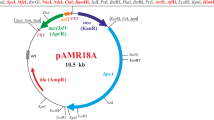Abstract
A method for the preparation and regeneration of protoplasts ofStreptomyces lincolnensis is described. Mycelium in the early exponential phase appeared to be most suitable for this purpose and yielded up to 25 % regenerated intact cells. Transformation ofS. lincolnensis protoplasts was achieved using broad-host-range streptomycete plasmid vectors pIJ622, pMP66, pRS410 and pIJ943 constructed from replacons pIJ101, pSLG33 and SCP2. The efficiency of transformation was 3·103 transformants per μg plasmid DNA when (2–5)·107 recipient protoplasts were used. Interspecific transformations showed that there is no efficient restriction system inS. lincolnensis that would limit the transfer of genetic information fromS. lividans orE. coli.
Similar content being viewed by others
References
Baltz R.H., Matsushima P.: Protoplast fusion inStreptomyces. Conditions for efficient genetic recombination and cell regeneration.J.Gen.Microbiol. 127, 137–146 (1981).
Bernan V., Filpula D., Herber W., Bibb M., Katz E.: The nucleotide sequence of the tyrosinase gene fromStreptomyces antibioticus and characterisation of product.Gene 37, 101–110 (1985).
Bibb M.J., Freeman R.F., Hopwood D.A.: Physical and genetical characterisation of a second sex factor, SCP2, forStreptomyces coelicolor A3(2).Mol.Gen.Genet. 154, 155–166 (1977).
Bibb M., Schottel J.L., Cohen S.N.: A DNA cloning system for interspecies gene transfer in antibiotic-producingStreptomyces.Nature 284, 526–531 (1980).
Brahme N.M., Gonzales J.E., Rolls J.P., Hessler E.J., Mizsak S., Hurley L.H.: Biosynthesis of lincomycin. I. Studies using stable isotopes on the biosynthesis of the propyl- and ethyl-l-hygric acid moieties of lincomycin A and B.J.Am.Chem.Soc. 106, 7873–7878 (1984).
Hoeksema H., Bannister B., Birkenmeyer R.D., Kagan F., Magerlein B.J., Mac-Kellar F.A., Schroeder W., Slomp G., Herr R.R.: Chemical studies on lincomycin. I. The structure of lincomycin.J.Am.Chem.Soc. 86, 4223–4224 (1964).
Hopwood D.A., Bibb M.J., Chater K.F., Kieser T., Bruton C.J., Kieser H.M., Lydiate D.J., Smith C.P., Ward J.M., Schrempf H.:Genetic Manipulation of Streptomyces. A Laboratory Manual. John Innes Foundation, Norwich 1985.
Huber M., Hintermann G., Lerch K.: Primary structure of tyrosinase fromStreptomyces glaucescens.Biochemistry 24, 6038–6044 (1985).
Huber M., Hütter R., Lerch K.: The promoter of theStreptomyces glaucescens mel operon.Nucl.Acids Res. 15, 8106 (1987).
Jandová Z., Tichý P.: Preparation of protoplasts and regeneration of intact cells ofStreptomyces cinnamonensis.Folia Microbiol. 35, 456–459 (1990).
Jenkins G., Zalacain M., Cundliffe E.: Inducible ribosomal RNA methylation inStreptomyces lividans, conferring resistance to lincomycin.J.Gen.Microbiol. 135, 3281–3288 (1989).
Kieser T., Hopwood D.A., Wright H.M., Thompson C.J.: pIJ101, a multi-copy broad host-rangeStreptomyces plasmid: functional analysis and development of DNA cloning vectors.Mol.Gen.Genet. 185, 223–238 (1982).
Lampel J.S., Strohl E.R.: Transformation and transfection of anthracycline-producingStreptomyces.AppLEnvironMicrobiol.51, 126–131 (1986).
Lydiate D.J., Malpartida F., Hopwood D.A.: TheStreptomyces plasmid SCP2: its functional analysis and development into useful cloning vector.Gene 35, 223–235 (1985).
MacNeil D.J.: A flexible boiling procedure for isolating plasmid DNA from gram-positive microorganisms.J.Microbiol.Meth. 5, 115–123 (1986).
MacNeil D.J., Klapko L.M.: Transformation ofStreptomyces avermitilis by plasmid DNA.J.Ind.Microbiol. 2, 209–218 (1987).
Mason D.J., Dietz A., De Boer C.: Lincomycin, a new antibitotic. III. Discovery and biological properties, pp., 554–559 in J.C. Sylvester (Ed.):Antimicrobial Agents and Chemotherapy, 1962. Am.Soc.MicrobioI., Ann Arbor (MI) 1963.
Matsushima P., Baltz R.H.: Efficient plasmid transformation ofStreptomyces ambofaciens andStreptomyces fradiae protoplasts.J.Bacteriol. 136, 180–185 (1985).
Ogata S., Koyama-Miyosh Y., Hayashida S.: Transfection and transformation systems for pock-forming and thiostrepton producingStreptomyces azureus.J.Fac.Agric.Kyushu Univ. 29, 179–188 (1985).
Okanishi M., Suzuki K., Umezawa H.: Formation and reversion of streptomycete protoplasts: cultural conditions and morphological study.J.Gen.Microbiol. 80, 389–400 (1974).
Petříček M., Smrčková I., Tichý P.: Transformation ofStreptomyces granaticolor with natural and recombinant plasmid vectors.Folia Microbiol. 30, 474–478 (1985).
Petříček M., Tichý P.:Streptomyces cloning vector derived fromStreptomyces lavendulae-grasserius mini-plasmid pSLG33.FEMS Microbiol.Lett. 61, 109–114 (1989).
Summers D.K., Sheratt D.J.: Multimerization of high copy number plasmids causes instability: ColE1 encodes a determinant essential for plasmid monomerisation and stability.Cell 35, 1097–1103 (1984).
Thompson C.J., Ward J.M., Hopwood D.A.: DNA cloning inStreptomyces: resistance genes from antibiotic-producing species.Nature 286, 525–527 (1980).
Thompson C.J., Ward J.M., Hopwood D.A.: Cloning of antibiotic resistance and nutritional genes in streptomycetes.J.Bacteriol. 151, 668–677 (1982).
Author information
Authors and Affiliations
Rights and permissions
About this article
Cite this article
Jandová, Z., Tichý, P. Transformation ofStreptomyces lincolnensis protoplasts with plasmid vectors. Folia Microbiol 37, 181–187 (1992). https://doi.org/10.1007/BF02933144
Received:
Issue Date:
DOI: https://doi.org/10.1007/BF02933144




